You can use many different sales and marketing channels to interact with prospects and existing customers. The best approach for your business will depend on your skillset, niche, and client base. One strategy you should experiment with, though, is online events.
Online events allow you to connect, converse, and partake in business with people worldwide. This guide will share five tips you can implement to attract warm leads for your company through online events. Before discussing that, let’s quickly touch on the fundamentals.
In this article
What is a warm lead, exactly?
A warm lead is a company or individual who has shown an interest in your services or products. They may have shown interest by signing up for your email newsletter, engaging with the content you produce online, making a sales inquiry, or something completely different.
Anyone involved in sales understands this all too well: generating warm leads and converting them into customers is incredibly difficult, particularly now that opportunities for face-to-face contact are not as abundant as before. The remainder of this guide will discuss how to use online events to generate more business leads.
How can online events assist in the generation of warm leads?
Online event marketing will help you attract warm leads for your online event as effectively as a physical event. Besides being cheaper to organize, online events are also cheaper to attend. Your participants don’t need to book flights or hotel rooms to attend the event. Online events help:
- To establish and strengthen company-client relationships in place of in-person events: For example, when the outbreak of COVID-19 restricted people from having physical meetings, online events kept people connected.
- To educate customers without going on-site: An online event allows people to attend training sessions and connect with other customers without leaving home.
- To offer a sneak peek at your upcoming products to your most loyal customers: By allowing your existing clients to get a first look at your new products or services, they’ll feel like they’re part of an exclusive group, which in turn builds loyalty to your business.
Aside from the three reasons above, businesses have other objectives for hosting virtual events, such as fundraising or member recruitment.
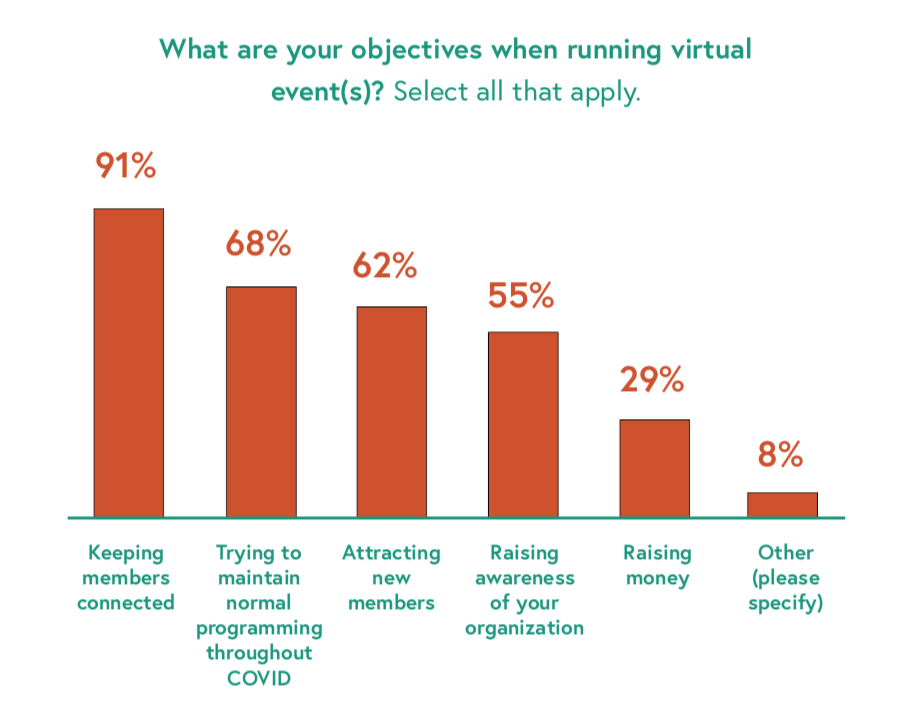
Online events are also a goldmine of data about your potential customers. You can analyze your list of participants to determine their location, industry, position, and business requirements. Using these insights, you can create more efficient, better-targeted marketing campaigns.
Here are five tips you can implement to help you run more successful online events.
1. Prepare a fantastic event
Like organizing a physical event, preparing for a successful online event requires mindful planning and strategic thinking. People will attend your online event if they know the value you are offering them. Make sure you show off all your assets so that your potential participants won’t want to miss the event.
One of the ways of making people attend your online event is by preparing the latest topics for the event. If you don’t offer anything new, your potential guests might choose to attend another event that promises the latest topics.
People always want to hear about recent topics. When this issue is adequately mastered, you can start sourcing speakers.
An excellent example of an outstanding virtual event is the Salesforce world tour Sydney Reimagined held on the 4th of March 2020. The event had 80,000 Livestream views and over 1 million video views in 24 hours. What made it so special? The event took days of serious planning. It included prolific speakers such as Trevoh Philpot, Tobi Skovron, Vu Tran, industry thought leaders in their fields such as tech and literature.
So, how can you replicate Salesforce’s success? Below are the steps to make a fantastic event:
Focus on the interests of your participants
First and foremost, you must concentrate on the value you intend to deliver to your participants. Why should they devote their time to your online event? You’ll have to ensure they get helpful information and gain actual value from the event.
Make sure you give your event a brief, descriptive title so that participants will know what to expect and what they’ll likely learn. You can also add a short description up to three sentences long, along with the topics you intend to cover during the event.
Select the proper platform for your online event
Online event marketing is flourishing every day, and new event platforms are being released regularly, making decision-making hard.
The kind of platform you should select for your event will be dependent on your goals. Usually, many small online events are held on free video conferencing applications like Webex. However, bigger online events might have different requirements. Various platforms offer different capabilities. You should consider the following before selecting a conferencing software:
- How many participants will attend?
- Will the presentation require screen sharing?
- Will the event have interactive elements, such as Q&A sessions?
- Does your event include focused discussions that require breakout rooms?
Ensure that you select a free platform for participants that’s simple to install and easy to use. Selecting a complicated platform might just turn people away. Most online events occur on Zoom because many people already use this platform and are familiar with the user interface.
If you intend to produce more online events in the future, you can consider subscribing to the paid version of Zoom, which lifts the 45-minute cap on meetings and other advanced features. You may also test other platforms, such as Filo, Eventcube, Orbits, and choose one that meets your needs.
Carefully plan your presentation
If you’re presenting, ensure your presentation is planned well in a lot of time, and practice until you get it right. A good presentation is interactive, brief and precise, with time set aside for Q&A. While there are no hard and fast rules for presentation lengths, a typical presentation lasts no longer than 45 minutes. If you intend to go further, you need to divide your presentation into shorter segments and insert short breaks in between. Also make sure you run your script through an online grammar checker to remove any errors.
Creating a presentation is just half the battle, though. You also need to ensure that you deliver it properly. Try presenting to an imaginary audience or invite your friends or colleagues to sit in and take notes.
External inputs go a long way in tightening your presentation and how you deliver it. For example, if your friends say you tend to linger too much on a specific slide, it might be time to divide the content into two or more slides.
Invite the proper speaker
Another way to convince potential leads to attend your online event is to invite a proper guest speaker. Looking for a speaker shouldn’t be tricky if you’ve attended enough industry events. You’ll know who the knowledgeable ones are and how to reach them.
Otherwise, you’ll need to get feedback from your existing customers about the people they’d like to hear. Once you’ve built a shortlist of potential speakers, you can do a background check on them, including the articles or books they’ve published, the events they’ve appeared in, and how their previous audiences perceived them.
Your guest speaker should be able to:
- Inspire and motivate participants
- Keep the participants entertained and engrossed
- Provide the participants with new ideas
Using the Salesforce world tour Sydney Reimagined as a case study, Trevoh Philpot, who discussed “Keys to power Human-Centric service,” kept the audience entertained by telling customer service stories they could relate to. At the end of his speech, he even gave them the links to his various social media accounts so that the audience could reach him after the event if they had any questions.
Ensure you contact potential speakers frequently. Send them a summary of what you want them to present and what you’ll offer in return. When in doubt, always ask for a copy of their standard speaker contract.
2. Invite the right people
Getting the right people to attend your online event is another efficient way of generating warm leads in online event marketing. You have to invite people who can buy your products or employ you.
The kind of people you’ll invite is dependent on the type of your business. For instance, if you sell an eCommerce platform, you’ll want to invite online store owners. Likewise, you’ll want to invite marketing managers if you are selling email marketing solutions, etc.
For example, if you want to invite a representative from a company and you don’t have their contact, here is how to go about it:
Go to the “people ” section of a company on Linkedin and search for the position of the individual which you’d like to invite. But you’ll have to do that carefully because various companies use different titles for related job roles.
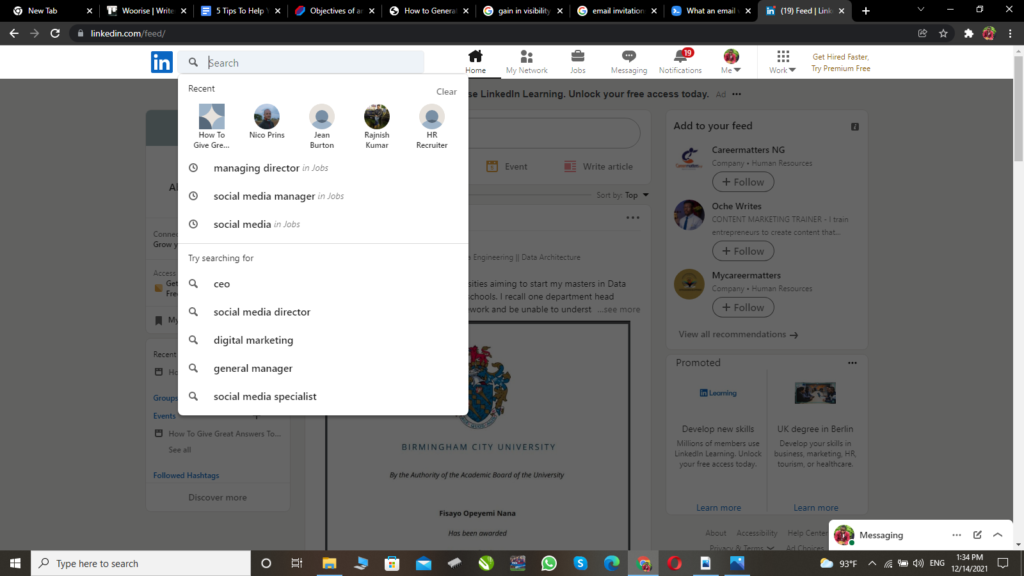
You can use an email finder like Hunter.io once you’ve discovered the person’s name and company domain:
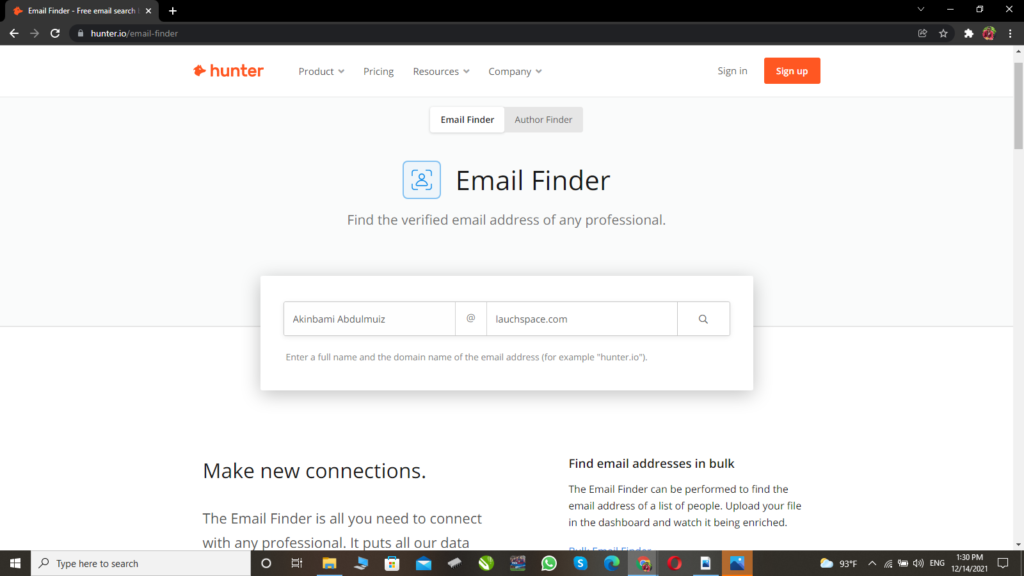
Your invitation emails should be brief, precise. Your invites should also contain all the essential information. Include a short description of the event and speakers, add the time and date of the event, plus a link for more information. Use an excellent subject line, add an image to the email, and use your prospect’s name to personalize the conversation.
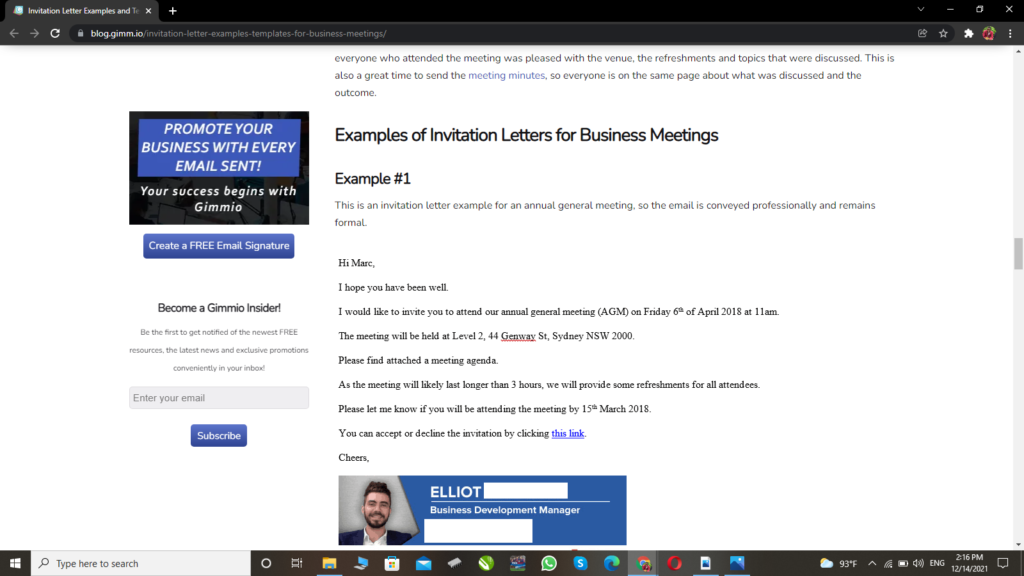
Finally, you need to create a great-looking landing page for your online event. Here’s an excellent example of a well-designed landing page for an online event hosted by the Content Marketing Institute.
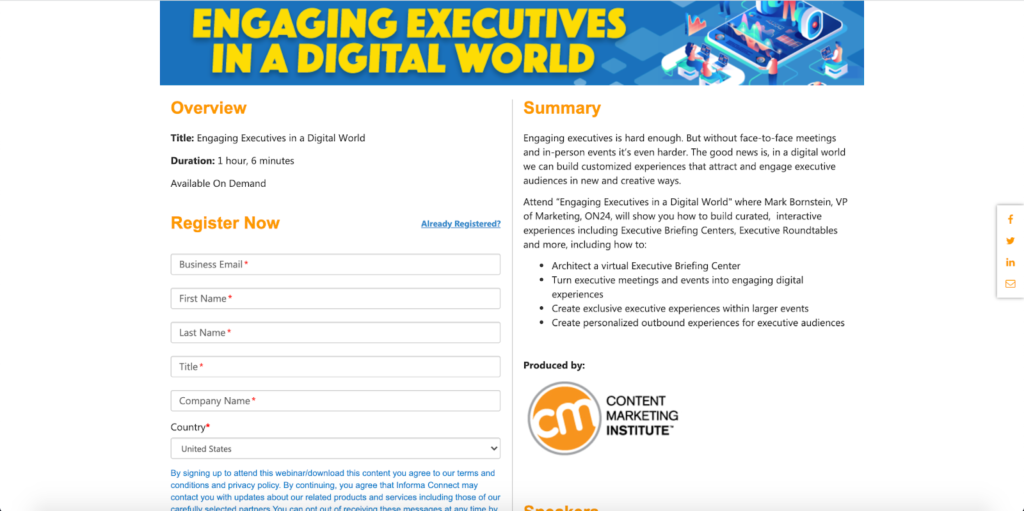
You don’t need technical knowledge to create a good landing page. You can learn how to create a good landing page and a registration form from Woorise. Notice the Content Marketing Institute landing page above. It has a friendly user interface and a simple yet catchy design. The institute brand logo is visible and apparent.
The summary on the right-hand side gives a brief and detailed explanation of the online event. The event duration is also mentioned.
That said, here are some elements your landing page should have:
- A simple design: Too many elements tend to distract the user.
- A catchy headline: A short description of the event will intrigue the user and convince them to read more
- Clear branding: If your landing page doesn’t follow your usual branding guidelines, your potential leads could end up confused.
- Mobile optimization: Most of your landing page traffic will come from mobile devices. If your landing page doesn’t look good on a mobile device, your leads probably won’t have the patience to look for your event using a desktop.
Your event landing page should convince your potential leads that registering for your online event is good. If you take care of this factor, you’ll have an easier time attracting new leads.
3. Make an enticing bonus offer
Because of the increasing number of online events, the market for online event participants is highly competitive. Offering a special bonus is an efficient method of online event marketing for your brand to gain exposure and attract more people to register. Shopify, for instance, offered people a free starter pack to get people to register for its webinar:
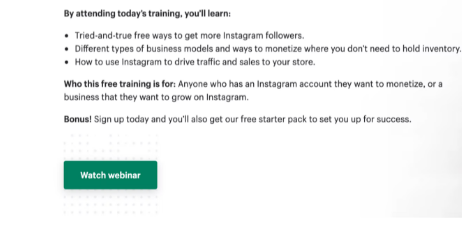
The event is free, too.
Make sure the bonus is connected to the event’s topic and your business. Examples include:
- Gift cards
- Free downloadable ebook
- Product discounts
You should make the bonuses limited to encourage people to sign up for your online event early. It’ll make people fear missing out on bonuses. Ensure the bonuses you’ll be offering provide real value to your leads.
4. Focus on pain points
A pain point is a specific issue that a potential attendee for your online event is experiencing. Pain points vary with participants. However, some of these participants are unaware of their pain points, which makes convincing them to attend your online event complex.
Pain points can be viewed as simple problems and are divided into four categories:
- Support pain point
- Productivity pain point
- Financial pain point
- Process pain point
Viewing pain points in these categories makes you think about how your online event can serve as a solution to the potential problems of your participants.
Your participants signed up for your online event because you promised to deliver them relevant content. One of the best ways for online event marketing to deliver this promise is to discuss the pain points and issues your potential customers face, then offer them solutions.
Let’s say you’ve identified a client’s pain point as “Unreliable customer service channels”. If consumers can’t get a quick answer to their questions online, they will likely abandon the purchase.
You should make your potential customers know the reasons behind this pain point and assure them that you have a long-lasting solution to this problem. You should also explain to them why your solution is better than others.
One major factor that will determine the success of your online event lies in identifying the issues that your target audience faces and providing them with a helpful solution.
5. Use the appropriate CTA
CTA (Call to Action) is one of the critical aspects of online event marketing. That should come at the end of the event, where you tell your participants what to do next. It should be easy, clear, and specific.
Your CTA should be something that aids in generating warm leads since that’s the primary goal. In achieving that, the CTA has to be something that drives participants to your sales page.
In creating a CTA that attracts warm leads, you should follow these procedures:
- Make use of action words: You aim to act. Use action words like register, join, start, etc.
- Create urgency: Creating urgency is also very important for products with low tickets. Use words like today, now, etc. You can also include countdown clocks when necessary.
- Make it enchanting: When a potential client visits your website; You should ensure that you present them with an irresistible offer. For instance, if you sell gadgets and offer 40% off the first customer purchase, you’ll quickly get the email or mobile number of the lead that seriously wants to buy any of the gadgets.
An excellent example of a converting CTA is the one created by Zeropark, a software company based in Poland:
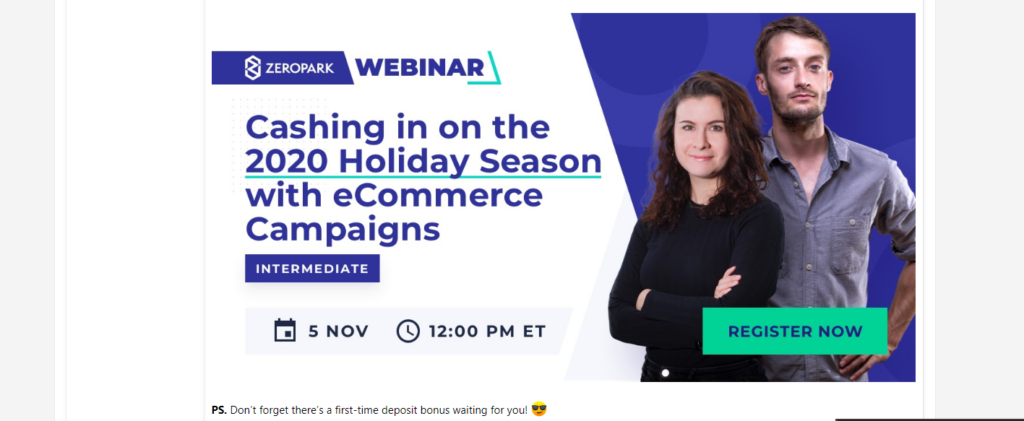
They used the action phrase ‘Register Now’ and the CTA is visible on the page.
The CTA you use is dependent on the type of your event and the kind of your business. You can ask your participants to sign up and get a free trial of your products or book a free consultation. Providing an accessible link or an online registration form will make it easy for your participants to take your desired action.
One of the best ways to use a CTA to attract warm leads for your online event is to make the CTA indirect and conversational. For example, you can use personal pronouns in your CTA text, such as “Tell us what you’re expecting”. You also need to use simple yet professional language.
Wrapping up
Online event marketing is a very efficient method of connecting with the right decision-makers and potential customers. It’ll help you convey relevant information and knowledge, discuss your audience’s pain points, and offer your business as a solution provider. Online events also help you build up your company’s credibility.
Signing up for an online event is evidence that an attendee is interested in what you have to offer. Therefore, your event should deliver what it promises. By following the steps outlined in this article, you can generate and sustain your audience’s interest and convince them to take action. Your conversion rate will gradually increase, generating excellent warm leads in your pipeline.



